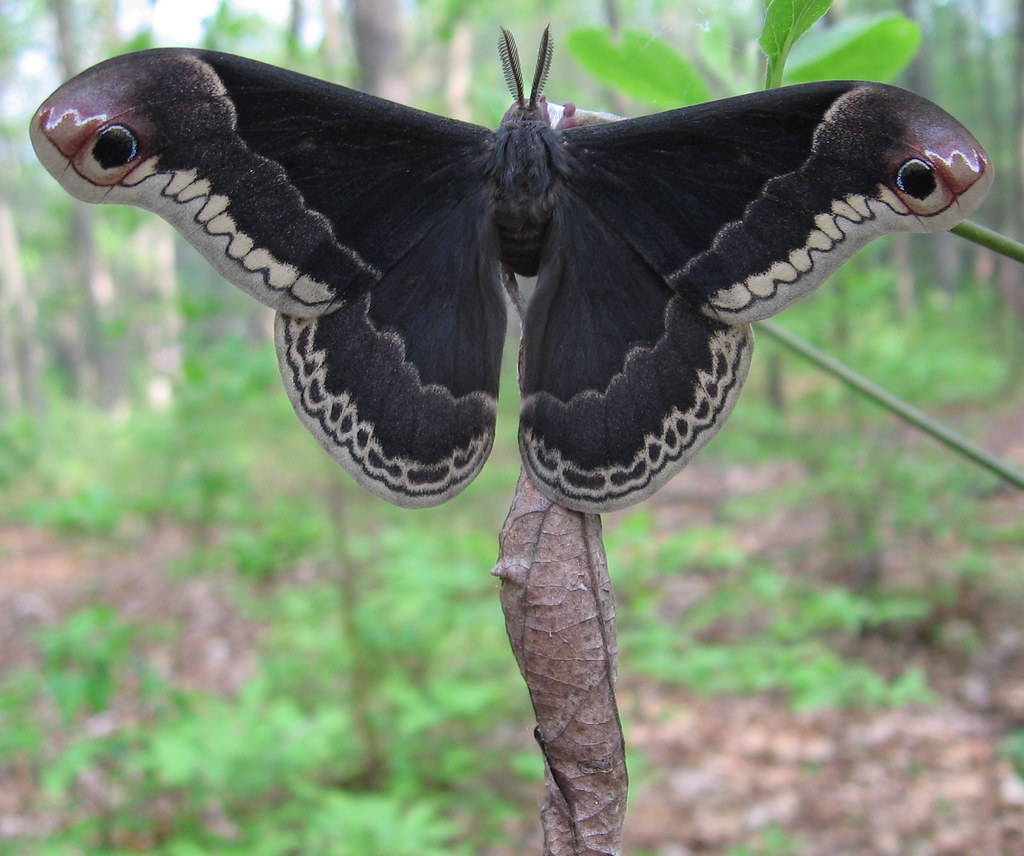Decoding the Promethea Moth
The Promethea moth (Callosamia promethea) stands out in the Lepidoptera world. Unlike its nocturnal relatives, this moth dances in the sunlight, showcasing its remarkable adaptations for survival. Let’s delve into the fascinating world of the Promethea moth, exploring its unique life cycle, ingenious defenses, and the challenges it faces in a changing environment.
Mimicry and Camouflage: A Tale of Two Strategies
Male and female Promethea moths employ distinct survival tactics, resulting in striking differences in their appearance. Males mimic the poisonous Pipevine Swallowtail butterfly, a phenomenon known as Batesian mimicry. Their deep maroon wings, punctuated by bold, eye-like markings, likely deter potential predators who mistake them for a toxic meal. This clever disguise allows them to fly freely during the day.
Females, on the other hand, opt for camouflage. Their reddish-brown and cream coloration blends seamlessly with the leaves of their host plants, making them virtually invisible to predators. This difference probably arises from the differing lifestyles of males and females: active males benefit from mimicry, while more stationary females rely on concealment. This is a captivating example of how evolutionary pressures shape appearances within a single species.
A Life Cycle of Transformation: From Egg to Imago
The Promethea moth undergoes a complete metamorphosis, a dramatic transformation from a tiny egg to a winged adult. The journey begins when a female moth meticulously selects a host plant and deposits her eggs. These host plants, which include spicebush, cherry, sassafras, lilac, and tulip tree, are crucial for the next stage of the moth’s life cycle. For a more complete list of these plants and other relevant information, check out our dedicated page on Promethea moth host plants.
From these tiny eggs emerge voracious caterpillars, sometimes called “giant silkworms.” These larvae embark on a feeding frenzy, consuming leaves and growing rapidly through several instars (molting stages). As they mature, their appearance changes dramatically, from a pale green with black stripes to a plump, bluish-green adorned with yellow and orange tubercles. More details on the caterpillar’s diet and growth can be found on our Promethea moth caterpillar diet page.
The Hanging Masterpiece: A Cocoon of Ingenuity
One of the most remarkable aspects of the Promethea moth’s life cycle is the construction of its cocoon. Unlike other silk moths that spin their cocoons directly on branches, the Promethea moth ingeniously wraps a leaf around itself, securing it to a twig with strong silk threads. This creates a hanging, pendulum-like structure that offers protection from predators and harsh weather. Inside this silken chamber, the caterpillar undergoes metamorphosis, transforming into a winged adult. The remarkable strength and durability of the silk have attracted scientific interest, with ongoing research exploring its potential applications. For details on how the moths find each other to mate in their habitat, please see our Promethea moth habitat page.
A Future Uncertain: Navigating Threats
While not currently endangered, the Promethea moth faces growing threats. Habitat loss due to deforestation and development reduces the availability of essential host plants. Climate change may also disrupt the timing of the moth’s life cycle, potentially affecting its synchronization with host plants. Some experts suggest that warming temperatures could shift their range northward, impacting their ability to survive in their current habitats. Supporting conservation efforts and planting native host plants in our gardens can create vital habitat patches, offering refuge for these fascinating creatures.
Promethea Moth: At a Glance
| Characteristic | Details |
|---|---|
| Scientific Name | Callosamia promethea |
| Family | Saturniidae (Giant Silk Moths) |
| Distribution | Eastern North America, extending westward to the Great Plains |
| Habitat | Deciduous forests and woodlands |
| Adult Activity | Diurnal (daytime) |
| Male Appearance | Dark maroon with prominent eyespots |
| Female Appearance | Reddish-brown and cream |
| Host Plants | Spicebush, cherry, sassafras, lilac, tulip tree, and others |
| Unique Feature | Pendulum-like cocoon attached to a twig |
Discover the timeless artistry of Pewabic tile, where iridescent glazes and intricate designs come to life. Explore the captivating world of renowned artist Philip Alan Hosterman and his evocative creations.
- China II Review: Delicious Food & Speedy Service - April 17, 2025
- Understand Virginia’s Flag: History & Debate - April 17, 2025
- Explore Long Island’s Map: Unique Regions & Insights - April 17, 2025

















2 thoughts on “The Mysterious Promethea Moth: Unveiling the Secrets of a Silk-Spinning Master of Disguise”
Comments are closed.